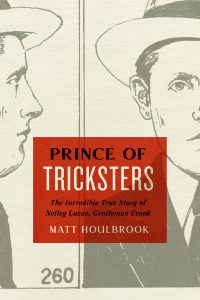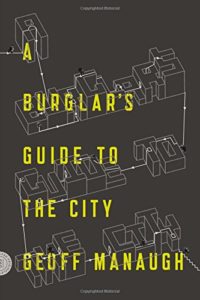14 November 2016 | crime, Detectives, Guardian, Reviewing |
Netley Lucas was a debonair and charming con man, described by the press as the "prince of tricksters". Matt Houlbrook has written a remarkable study of this extraordinary character who died in 1940, aged just 36. He was a notorious confidence trickster, convicted thief, concocter of fake crime news stories, and the writer and publisher of bogus royal biographies.

Lucas changed identities as easily as others change their clothing. Houlbrook admits being fascinated by the motivation of this gentleman crook: "I'm obsessed with making sense of you."
He began his criminal career aged just 14. A friend later recalled how convincing Lucas could be: “I had no idea that he was other than he pretended to be…he had a fascinating way with other men and women. He would look you straight in the face and assure you that he was lord somebody or a hero of the war – and you believed him.”
Lucas monetised his genteel manners and appearance, sweet-talking hotel managers and shopkeepers, turning charm and class into credit. By 17, he was driving around in a chauffeur-driven Daimler from Harrods and socialising with duchesses and chorus girls. Later he went on to reinvent himself first as a crime journalist and then as the author and publisher of royal biographies. After he published a biography of Queen Mary in 1930, she went through a copy of the book highlighting the errors: “I have annotated this book to show what a number of inventions are written about one.”
For Houlbrook, Lucas’s life-story reveals deeper truths about the period after the Great War in which the boundaries between class and gender were shifting. New forms of mass culture and democracy were changing how people viewed the state’s institutions and offered greater possibilities of social reinvention: “Lucas’s crimes were unusual, but his aspirations echoed those of countless ordinary men and women in a period when advertising encouraged dreamlike fantasies of social mobility.”
Lucas’s success as a confidence trickster suggested that in an "age of disguise" all you needed was money and a veneer of class to pass yourself off as a gentleman. In a society of strangers, his crimes were deeply subversive.
You can read my Guardian review of Houlbrook's book here.
01 September 2016 | Detectives, German culture, Reviewing, TLS, Watching the Detectives |
I've just reviewed a new collection of essays on Crime Fiction in German, edited by Katharina Hall who, as well as being a Professor of German, blogs on international crime fiction at Mrs Peabody Investigates. Apparently it's the first study in English “to offer a comprehensive overview of German-language crime fiction from its origins in the early nineteenth century to the post-reunification Germany of the new millennium”.

It's an absolutely fascinating collection, one which has proved very useful to me in my research for Watching the Detectives. You can download Professor Hall's introduction to the volume for free here. Unfortunately you will have to buy a copy of the Times Literary Supplement to read my review. Or if you have a subscription you can read it here.
28 June 2016 | cities, City |
I've been talking to Darran Anderson, author of the remarkable Imaginary Cities, at Strange Horizons. It was great fun! Hope you enjoy it too.
Read the conversation here.
25 June 2016 | architecture, cities, Reviewing |

I've just reviewed Geoff Manaugh's new book, A Burglar's Guide to the City, for the Guardian.
Here's a passage from my review:
Burglary, Manaugh writes, is “topology pursued by other means: a new science of the city, proceeding by way of shortcuts, splices and wormholes”. Burglars don’t see the city we see. They see a city full of vulnerabilities to be used for breaking and entering. They see lift shafts that can be shimmied up, thermal cameras that can be disabled with hair spray, and doors that can be easily opened with lockpicks. They see plaster-board walls that can be cut through in an instant with the right tool: “like clouds, apartment walls are mostly air”. According to Manaugh, burglars understand the architecture of the city better than anyone. They are the “dark wizards of cities and buildings, unlimited by laws that hold the rest of us in”.
The book is full of wonderful anecdotes and insights, both into architecture and the city. If, like me, you're a fan of Geoff's website then you'll love this book. It offers a delightfully playful and subversive view of the built environment, fizzing with ideas and new ways of looking at the spaces we inhabit. Read the review here and I hope you enjoy the book.
30 November 2015 | cities, London, Reviewing |
Did you know that Herman Melville was the first to compare London’s fog to pea soup, in 1849? No, I didn't either. I found this in Christine Corton's brilliant new history of the Big Smoke - London Fog. It wasn't just a problem in the nineteenth century either. In the eighteenth century Joseph Haydn, who was living in Great Pulteney Street, complained: "There was a fog so thick that one might have spread it on bread. In order to write I had to light a candle as early as 11 o'clock."
But the fogs of the middle of the nineteenth century were especially thick, thicker even than Melville's pea soup "of a gamboge colour". Thomas Miller, a writer, said "it is something like being imbedded in a dilution of yellow peas-pudding, just thick enough to get through it without being wholly choked or completely suffocated. You can see through the yard of it which, at the next stride, you are doomed to swallow, and that is all."
It's thickness and overpowering smell of carbon and sulphur gave it the almost tangible density of food. HV Morton, in The Heart of London (1925), suggested that the city's fog even had a local taste: "The fog has a flavour. Many flavours. At Marble Arch I meet a delicate after-taste like melon; at Ludgate Hill I taste coke."
Bob Hope, the London-born comedian, continued the food theme, joking that Californian smog was "fog with the vitamins removed". By the way, interestingly Corton notes that the word "smog" was never really used at the time to describe London's fog and was only used in retrospect.
Anyway, I enjoyed Corton's highly original study immensely. You can read my review of it on the Guardian's site.




